So what was Saturnalia?
The fact is, the Romans loved festivals, and 'officially', Saturnalia commemorated the winter solstice, as well as honouring Saturn, the god of agriculture, wealth, and liberation. Most Roman holidays were never confined to a single day, and Saturnalia was a week-long celebration, lasting from the 17th to either the 23rd or 24th of December. Described by the Latin poet, Catullus, as "the best of days", it was the most popular holiday of the Roman calendar, attested by the fact that many of its traditions still survive to this day.
Its exact date of origin is unknown, though references to the holiday are made as early as the 4th century B.C. Like other holidays and festivals, at its core, Saturnalia was a religious observance. Albeit, most of the religious aspects were only observed on the first day.

Io, Saturnalia! And a World Turned Upside Down
Much like "Merry Christmas" or "Happy Holidays", the Romans had their own greeting for the season. The first word was pronounced either 'eye-oh' or 'yo', with both being deemed technically correct (potato, potatoe...). It could mean just about anything, and was often shouted by revellers in the midst of committing acts of naughtiness.
During Saturnalia, courts were suspended, as were many laws. Roles were also famously reversed, with slaves becoming masters, and their masters having to serve them. The extent of this varied from house to house. It is most likely that, while servants did have their own formal banquet with the masters serving them, the food was already prepared.
Not all emperors were as enthusiastic about the 'week of mischief'. The rather stoic Augustus attempted to have Saturnalia reduced to a single day. Even the notorious 'party animal', Caligula, tried to reduce the celebrations to three days. Because Saturnalia was so universally popular, neither of these attempts met with any sort of success. In the end, both Augustus and Caligula were obliged to yield to the will of the people.
Saturnalia Traditions
The week of naughtiness also saw a number of traditions, many of which still carry on to this day. These include, but are not limited to:
The Saturnalia Tree, Wreath, and 'Boughs of Holly'
The modern Christmas tree has origins in both Norse and Roman traditions. While the Norsemen used evergreens, as they were viewed as a symbol of eternal life, the Romans used just about any tree that was growing where they lived. They also did not chop down the trees and place them in their homes; that came from the Germans during the Renaissance and has been attributed to Martin Luther.
Because the winter solstice was about the rebirth of the sun, the sun god Sol Invictus got his share of attention as well. Many of the ornaments decorating Saturnalia trees were in the shapes of stars or suns. Images of the double-faced god, Janus, were also popular, as were gold and silver-coloured orbs, much like today.
Food, in particular cookies and shaped biscuits, were also used to decorate trees. These were often shaped like suns, moons, children (as a sign of fertility), or animals. So yes, the Christmas gingerbread man also has Saturnalia origins.
And while trees remained outdoors, people decorated their homes with a lot of greenery; symbols of life, fertility, and the harvest. Streamers of red and gold were often interlaced with these. Wreaths were also hung from doorways and from public buildings.
Of interesting Note: The hanging of Mistletoe is actually a Nordic tradition that dates back to ancient Scandinavia and the myth of Baldur. The burning of the Yule Log is also Nordic, as is the term 'Yuletide', which dates to ancient Germanic paganism.
People also decorated themselves with lots of greenery, as well as copious amounts of costume jewellery. Laurel crowns were often worn by both men and women alike. Such dress and spectacle often rolled into the next ancient tradition...
The Singing of Carols
Christmas carolling today is a far more subdued affair than it was in Ancient Rome. During the Saturnalia week, groups of people would go from house to house, beating drums, playing their pipes, while singing any number of songs. These 'carollers' were usually drunk, and often naked. Sadly, the practice of nude carolling has fallen out of favour in recent years. I blame it on the December climate in North America and much of Europe, which makes naked prancing a less-than-merry experience.
The Giving of Gifts
On the third day of Saturnalia (hey, that could be a song! Somebody write that down...), 19 December, was the Sigillaria. The term 'Sigillaria' refers to pottery or wax figurines, that were often given as gifts. The term came to encompass all Saturnalia presents, not just wax figures and pottery. Despite his attempt to reduce Saturnalia to a single day, Emperor Augustus was quite fond of gag gifts, as was Emperor Vespasian. The poet, Martial, describes a variety of gifts given during the Sigillaria. Much like today, they vary greatly between the cheap and expensive. Some examples he listed include: perfume, sausage, pipes, books, an axe, a parrot, tableware, cutlery, slaves, or exotic animals.
Employers, patrons, as well as masters of households also gave gifts to their employees or servants. Even slaves were given often lavish presents by their masters. The British tradition of Boxing Day was at least partially influenced by this ancient custom.
The King / Queen of Saturnalia
During the Empire, a new tradition emerged, where one man (or sometimes woman) became the master of ceremonies for the celebration. Much like the Lord of Misrule in Medieval England, the Saturnalicius princeps deliberately (mis)rules, creating chaos, while being served by his or her fellow revellers. Both the King of Saturnalia and the Lord of Misrule were determined by lot, and could be anyone, even a slave. Most of the commands given by the king included subjecting guests to humiliating stunts, such as requiring them to sing naked, or else having someone either spanked or tossed into a fountain.
Like modern-day Christmas, Saturnalia was always evolving, with new traditions added over the generations. The Saturnalicius Princeps / King or Queen of Saturnalia, is not mentioned at all in Republican sources. It came about as a satiric response, following the rise of Emperor Augustus around 27 B.C. Surprisingly, most emperors took such satire in stride. Even the notoriously gloomy Tiberius was good-natured about the perceived ridicule during Saturnalia.
During the reign of Domitian, in 95 A.D., the poet Statius clarifies that, "Like Jupiter above, the emperor lords over all, even during Saturnalia." So apparently the world was not turned completely upside down.
The Day of Sol Invictus
During the later 3rd century A.D., the cult of the son god, Sol Invictus, became increasingly popular. As the winter solstice and Saturnalia marked the 'rebirth' of the sun, 25 December was proclaimed Dies Natalis, Sol Invictus, the 'birthday of the Unconquered Sun'.
Assimilation into Christmas
At no time in the history of the early Christian church was it ever thought that the birth of Christ took place on 25 December. In fact, Jesus' birthday was not celebrated at all until the mid-4th century. The 12th century Syrian bishop, Jacob bar Salibi, records, "It was a custom of the Pagans to celebrate on the same 25 December the birthday of the Sun, at which they kindled lights in token of festivity. In these solemnities and revelries the Christians also took part. Accordingly when the doctors of the Church perceived that the Christians had a leaning to this festival, they took counsel and resolved that the true Nativity should be solemnised on that day."
In other words, all of Christendom knew that Christ had not been born anywhere near 25 December; however, since the Roman holiday of Saturnalia was still very popular, it was much easier to merge the story of Jesus' birth with a celebration that had already existed for well over 800 years. And in actuality, Christmas only usurped Dies Natalis, Sol Invictus, with the Church leaders cleverly merging the sun king with Christ, 'The light of the world'. All of this was actually common knowledge, even through the 18th and 19th centuries. It wasn't until the 20th century that the masses started confusing 25 December for Christ's actual birthday. Should this change anything for Christians? I wouldn't think so. One could think of it like how the British celebrate the Queen's official birthday in June, regardless of the actual date of the monarch's birth.
Oh, and that jolly fat man who breaks into people's houses to deliver presents? He's actually a Turk from Myra...
Christmas's Saturnalia Heritage
The winter solstice is a time of celebration, with traditions that stretch back to earliest recorded history. And as we can see just from the number of Roman traditions that carry on to this day, no one holiday or religion has a monopoly on the Reason for the Season. So whether one says 'Merry Christmas', 'Happy Hanukah', 'Happy Kwanza', or whatever your pleasure, I wish you all the Happiest of Holidays, and...
For more information about hosting your own Saturnalia celebrations, please visit our friends at Nova Roma.
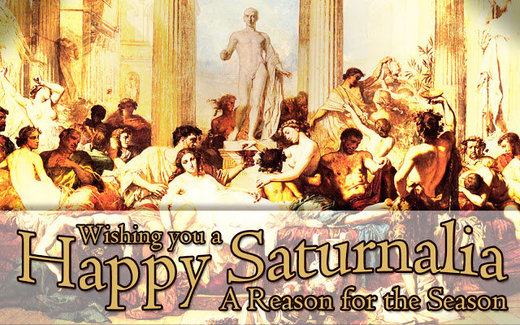
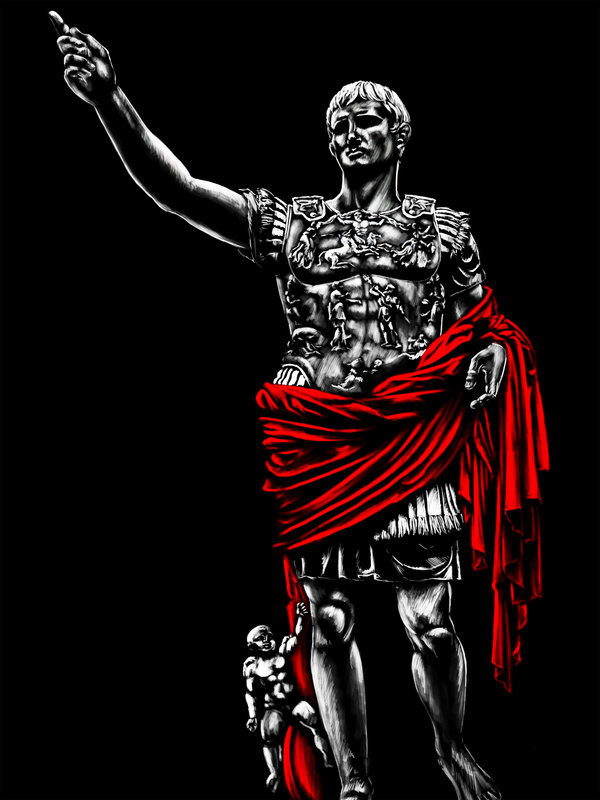

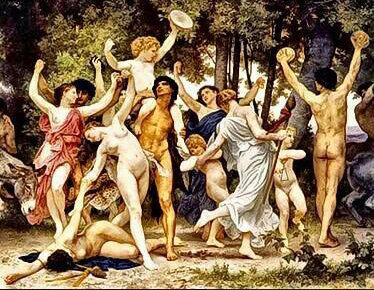
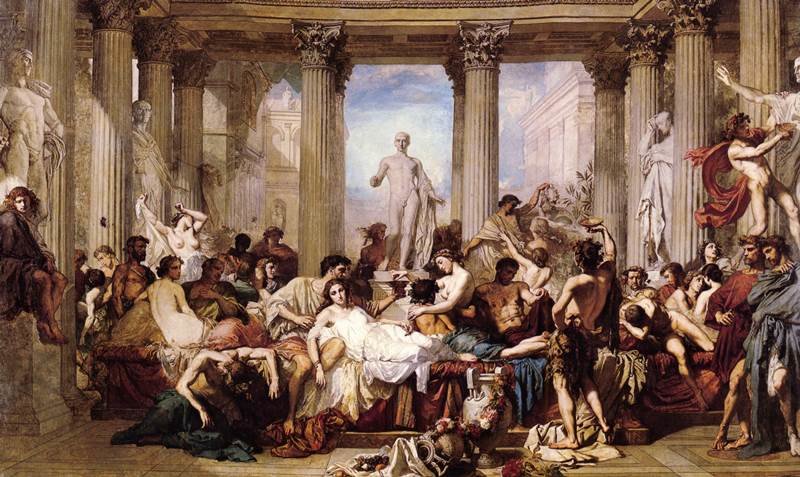
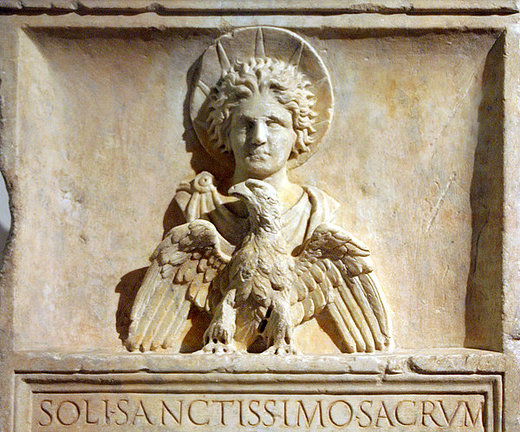
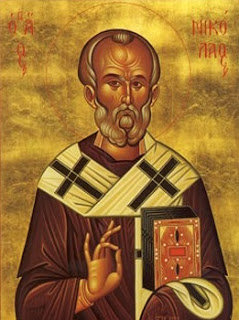
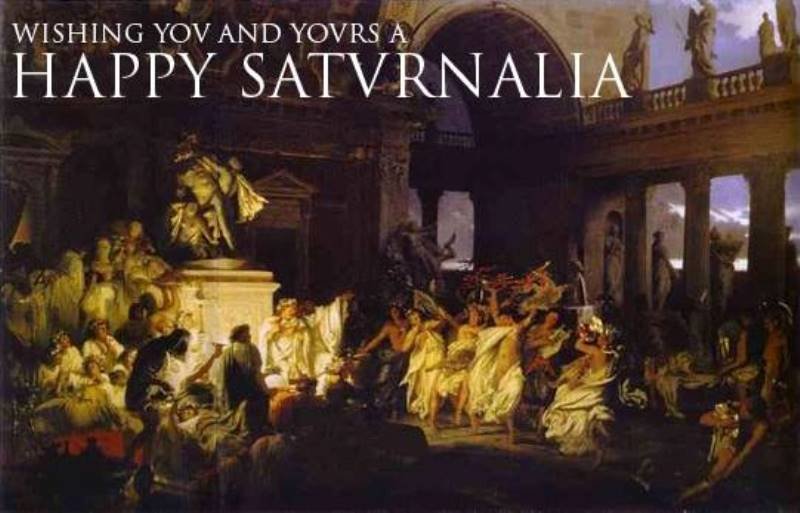



Reader Comments
to our Newsletter